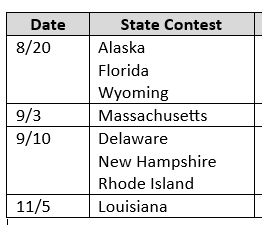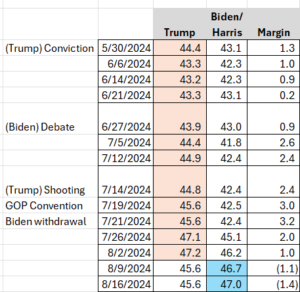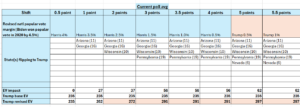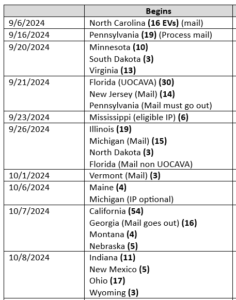Introduction
America is getting close to the “final sprint” to the November 5 election, as the Democratic convention in Chicago commences in 2 days.
On the Congressional/statewide primary circuit, five more states (Connecticut, Hawaii, Minnesota, Vermont, and Wisconsin) held their primaries this past week, while three more states (Alaska, Florida, and Wyoming) will hold Tuesday primaries. Which means that by Wednesday morning, only five states have not yet held their primaries. Four of those five contests will be held in early September, while the Louisiana primary coincides with the Federal Election Day of November 5).
With Labor Day just over two weeks away, what has been going on (from a polling perspective) with the Presidential race?
Presidential Polling
When discussing polling for the 2024 Presidential contest, there are two atmospheric challenges the party in power/its nominee Kamala Harris faces: (1) while her approval ratings have improved since the Biden withdrawal from the race, they still remain “underwater” (her 45-48% approval/disapproval according to 538 is a small improvement over her 43-49% approval/disapproval a week ago), and (2) persistent high disapproval (43-55% approval/disapproval according to a 7 day average of polls taken) of the Biden administration. Since Kamala Harris is still Joe Biden’s Vice-President, that persistent disapproval is a negative weight on her campaign, and President Biden’s getting a speaking slot on the first night of the Democratic convention will further reinforce that association in voters’ minds.
In the aftermath of the Biden withdrawal, the Harris campaign initially benefitted from a three-week honeymoon that involved both a smoothly executed rollout of her campaign and a leak-free Vice Presidential selection process. However, her record (and the record of her running mate) are undergoing increased scrutiny, and previous upward movement in the polls has stalled – in fact, there have actually been some polls released this past week both at the national and swing state level showing Trump ahead. JMC’s weekly 7 day polling average has picked up on this plateauing, and what was a 1.1% lead that the Harris/Walz ticket had a week ago is now only 1.4%.
From a numerical/trend perspective, that means that a 3.2% Trump poll lead four weeks ago has moved 4.6% “to the left” to a 1.4% poll deficit. Most likely, Democrats will get some incremental benefit next week with its convention dominating news coverage. However, the author is stressing that any “Democratic bounce” will likely be minor because (1) existing polarization in the American electorate means there is little room for much partisan movement either way, and (2) political conventions don’t have the “game changing” capability they once did, as the “news value” of them in voters’ minds has declined over time.
Given that the national polling numbers seem to have stabilized, the previously forecast 4-5% Harris lead before Labor Day will likely be in the 2-3% range at the conclusion of the convention. Below is a representation of the weekly changes in the national poll averages over the last several months:
When discussing the news value of polls taken at a national level, it’s important (in terms of putting those national polling numbers in their proper context) to realize that the Electoral College (and not the national popular vote) actually elects a President. That distinction does marginally benefit the Republicans. In other words, because of an inefficient vote distribution of Democratic and Republican votes across the 50 states, it’s possible for a Republican to be elected President without attaining a popular vote majority (or even a plurality), because California and New York have in recent election cycles generated larger Democratic vote margins than Florida and Texas have for Republicans – while those large margins in California/New York run up the score nationally, they don’t get a Democratic candidate any closer to the needed 270 electoral votes.
National popular vote vs the Electoral College
To illustrate the disconnect between the Electoral College and the national popular vote, Joe Biden was elected in 2020 with a 4.5% popular vote margin (51.3-46.8%) over Donald Trump. He also “won” the Electoral College 303-235 using applicable numbers for the 2024 Presidential election (270 electoral votes are needed to win), Biden’s Electoral College victory was due to narrow victories in several states, like Arizona, Georgia, Michigan, Nevada, Pennsylvania, and Wisconsin.
From that starting point of a 4.5% national popular vote win, we can assess the extent to which shifts in the national popular vote towards Trump could flip specific swing states, as national shifts can and will have an impact in both swing and non-swing states. To be conservative in his analysis, JMC is assuming that only half of a national popular vote shift (percentagewise) would occur in a swing state, since those states (which get an oversized amount of attention from either side) tend to be less elastic in their movement towards a candidate.
Still, even with this conservative analysis, any movement towards Trump relative to a 4.5% national popular vote deficit would “flip” states to Trump that narrowly voted for Biden in 2020. For example, even a Kamala Harris national popular vote win of 3.5% (a shift of only 1% towards Trump, in other words) would flip Arizona and Georgia, and those two flips would then put Trump up to 262 electoral votes – 8 electoral votes shy of a victory. A Harris win of 2.5% (a 2% shift towards Trump relative to 2020) would also flip Wisconsin and get Trump to the necessary 270 electoral votes.
Let’s translate that theory into “real world” terms: the last seven days of national polling show an average lead for Kamala Harris of 1.4% (she’s up 47.0-45.6% over Trump), which would translate to 291 electoral votes for Trump. In other words, a 1.4% Harris lead equals a 3.1% swing to Trump relative to his 2020 popular vote loss. A swing of that magnitude (even accounting for swing states’ being less elastic than the rest of the country) would flip Arizona, Georgia, Pennsylvania, and Wisconsin and give Trump the electoral votes he needs to win. Below is a representation of the electoral college impact of various national popular vote possibilities.
The early vote
While technically Election Day is November 5, an increasing number of voters are choosing to vote before that. Research done shows that 45% voted early in 2016, and that number surged to 69% in 2020. While the pandemic/mass adoption of mail voting obviously contributed to the increase in early voting in 2020, the reality is, Election Day voting is nevertheless becoming a thing of the past for an increasing number of people, and that changed behavior DOES impact when campaigns can most effectively disseminate their messaging to voters.
In practical terms, “Election Day” actually begins on September 6, when North Carolina sends out mail ballots, and accelerates when Minnesota, South Dakota, and Virginia become the first states (on September 20) to start in person early voting. As more states start early voting as we advance through the election calendar, by October 8, states constituting a majority of the Electoral College will have their “Election Days” underway. Below is a calendar of the first month of early voting:
Conclusion
Even though the last four weeks have not been good for Republicans, existing polarization of the electorate, combined with scrutiny over Kamala Harris and Tim Walz’s statements/prior actions seems to have stabilized the race. While Harris will likely get some benefit from the upcoming convention, candidate debates will likely have some impact as well, although it’s important to appreciate that the campaign clock is starting to tick: in 20 days, mail ballots go out in North Carolina, while in person early voting commences on September 20 in Minnesota, South Dakota, and Virginia.
What this means in practical terms is that the bulk campaign season (in terms of movable voters) will be the month of September, because states will be steadily ramping up their early voting throughout October.




